Introduction
What is Nationally Important Agricultural Heritage?
Agricultural Heritage
-
Agricultural production
Food production, livelihood Producing agricultural products, securing economic value, maintaining sustainable production and the agricultural environment -
Agricultural landscape
Land use, formation of the agricultural landscape Producing agricultural products, securing economic value, maintaining sustainable production and the agricultural environment -
Traditional culture
Transmission of traditional knowledge and agricultural culture Producing agricultural products, securing economic value, maintaining sustainable production and the agricultural environment -
Ecology
Biodiversity and environmental preservation Securing biodiversity and genetic resources, continuing environmental preservation
- Tangible and intangible resources, including agricultural technology, biodiversity, agricultural culture, community activities, and landscapes that have been formed and developed over a long period of time while adapting to the local environment.
- Introduction of the World Food and Agricultural Technology (FAO) World Important Agricultural Heritage in 2002, Nationally Important Agricultural Heritage System (NIAHS) in 2012
- Preparation of legal grounds for the conservation and utilization of agricultural heritage in 2015 (Article 30-2 of the Quality of Life Act for Farmers and Fishers)
- Agricultural heritage is a ‘living heritage.’ Agricultural heritage is a living heritage that evolves while adapting to environmental changes in politics, society, economy, culture, and ecology.
- An agricultural system based on traditional knowledge and practices accumulated over generations that reflects mankind’s evolution and profound harmony with nature.
- Exceptional aesthetic beauty
- Agricultural biodiversity and resilience of the ecosystem
- Creation of valuable cultural heritage
- This refers to the product of a unique agricultural activity or culture completed over generations, such as rice terraces built on sheer cliffs or centuries-old tea trees.
- The FAO defines agricultural heritage as “remarkable land use systems and landscapes which are rich in globally significant biological diversity evolving from the co-adaptation of a community with its environment and its needs and aspirations for sustainable development.”
- It emphasizes that mankind has contributed to the development of mankind and harmony with nature based on accumulated knowledge and experience. However, many of these unique agricultural heritages have disappeared due to the industrial revolution and scientific and technological development in the 19th and 20th centuries. Because of this, the agricultural heritages that have survived to this day are very valuable from the perspective of global agricultural culture and environmental protection.
Designation status of Nationally Important Agricultural Heritage
- Tangible and intangible resources, including agricultural technology, biodiversity, agricultural culture, community activities, and landscapes that have been formed and developed over a long period of time while adapting to the local environment.
- A total of 17 agricultural heritages have been designated as Nationally Important Agricultural Heritages, starting with the designation of No. 1, Cheongsando gudeuljang rice paddies, and No. 2, field walls in Jeju, in 2013, and finishing with No. 17, Changwon dokmoe persimmon agriculture, in 2022. Among these, Sangju traditional dried persimmon agriculture was designated as the 15th Nationally Important Agricultural Heritage in 2019.
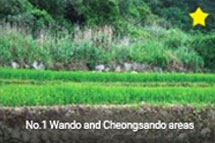
| Designation No. | No.1 | Name | Cheongsando Gudeuljang Paddies | Location | Wando and Cheongsando areas |
|---|---|---|---|---|---|
| Main characteristics | The traditional ondol method was introduced to adapt to the natural environment where rice paddy farming is unfavorable due to steep slopes with many stones and severe water loss, and a unique gudeuljang method was used to create waterways and rice fields. | ||||
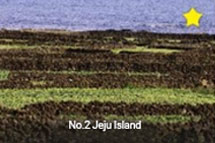
| Designation No. | No.2 | Name | Jeju Batdam | Location | Jeju Island |
|---|---|---|---|---|---|
| Main characteristics | Preventing wind and soil loss, creating agricultural biodiversity and beautiful agricultural scenery by building batdam to adapt to the barren natural landscape with lots of stones and wind | ||||
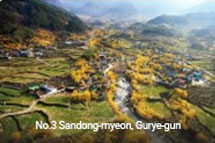
| Designation No. | No.3 | Name | Gurye Sansuyu Agriculture | Location | Sandong-myeon, Gurye-gun |
|---|---|---|---|---|---|
| Main characteristics | Cornelian cherries are planted around houses and farmland to maintain livelihood, and they form beautiful scenery that harmonizes with the surrounding landscape and a variety of habitats, and utilize traditional farming methods for fertilization and seed removal. | ||||
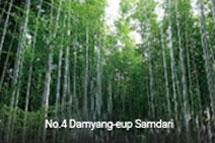
| Designation No. | No.4 | Name | Damyang Bamboo Fields | Location | Damyang-eup Samdari |
|---|---|---|---|---|---|
| Main characteristics | Bamboo forests form a unique agricultural landscape and habitat for various creatures, and traditional farming methods using bamboo vinegar and bamboo charcoal are applied for pest control and soil improvement. | ||||
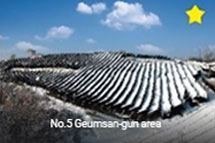
| Designation No. | No.5 | Name | Geumsan Ginseng Agriculture | Location | Geumsan-gun area |
|---|---|---|---|---|---|
| Main characteristics | The best place for ginseng cultivation. Traditional farming methods for plantation site selection, management, cultivation, mining, and processing have been maintained, creating a landscape harmonized with the surrounding mountains and rivers. | ||||
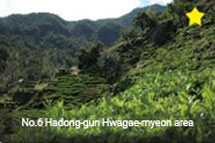
| Designation No. | No.6 | Name | Hadong Traditional Tea Agriculture | Location | Hadong-gun Hwagae-myeon area |
|---|---|---|---|---|---|
| Main characteristics | Traditional agriculture that has been handed down for 1,200 years to maintain livelihoods. Traditional tea cultivation such as pulbibae has been maintained, creating a unique landscape harmonized with the forests and rocks around the tea plantations. | ||||
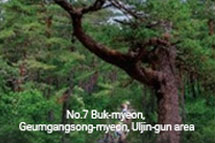
| Designation No. | No.7 | Name | Uljin Geumgangsong Mountain Agriculture | Location | Buk-myeon, Geumgangsong-myeon, Uljin-gun area |
|---|---|---|---|---|---|
| Main characteristics | Designated and managed by the royal family as hwangjangbongsan, and managed by organizing songgye and sanlimgye to protect the forest, creating a beautiful landscape harmonized with the surrounding valleys and strangely shaped rocks. | ||||

| Designation No. | No.8 | Name | Buan Yuyu-dong Sericulture Agriculture | Location | Yuyu-dong, Byeonsan-myeon, Buan-gun area |
|---|---|---|---|---|---|
| Main characteristics | The overall system from mulberry cultivation to silkworm breeding is preserved and managed for eco-friendly mulberry cultivation, biodiversity, And excellent scenery in harmony with surrounding forests and mulberry fields. | ||||
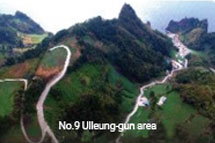
| Designation No. | No.9 | Name | Ulleung Volcano Line Agriculture | Location | Ulleung-gun area |
|---|---|---|---|---|---|
| Main characteristics | While cultivating steep-slope fields, green belts were created to prevent soil loss. Organic matter from the surrounding forests is utilized, plants native to Ulleung are cultivated, and a unique patchwork landscape has been created in which the forest and the coast are harmonized. | ||||
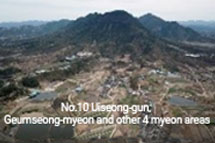
| Designation No. | No.10 | Name | Uiseong Traditional Irrigation Agricultural system | Location | Uiseong-gun, Geumseong-myeon and other 4 myeon areas |
|---|---|---|---|---|---|
| Main characteristics | Around 1500 proposals were reviewed in the area of Geumseong-myeon, which has a 2,000-year agricultural history dating back to the Three Han Dynasty Jomun country period. Through this, a double cropping conversion system was established for storing and utilizing agricultural water. | ||||
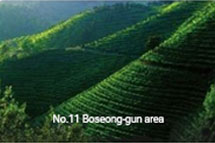
| Designation No. | No.11 | Name | Boseong Traditional Tea Agricultural System | Location | Boseong-gun area |
|---|---|---|---|---|---|
| Main characteristics | The creation of terraced tea planation technology using ropes as datum lines, adjusting the spacing and level by slope contour, and the landscape | ||||
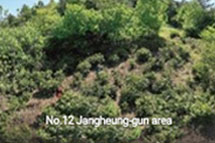
| Designation No. | No.12 | Name | Jangheung Fermented Tea Cheongtaejeon Agricultural System | Location | Jangheung-gun area |
|---|---|---|---|---|---|
| Main characteristics | Establishment and passing down of a tea cultivation environment of half-shade and half-light, eco-friendly farming method, a traditional manufacturing knowledge system for fermented tea, and the unique cheongtaejeon tea drinking method | ||||
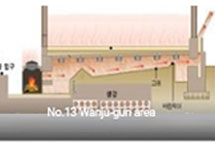
| Designation No. | No.13 | Name | Wanju Ginger Traditional Agricultural System | Location | Wanju-gun area |
|---|---|---|---|---|---|
| Main characteristics | A storage system using underground caves to store ginger seeds in winter, and an ondol method using the heating of furnaces in farmhouses and a vertical drop method, etc. | ||||
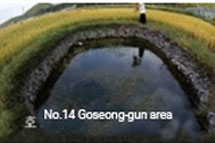
| Designation No. | No.14 | Name | Doombeong Irrigation System in Goseong Coastal Area | Location | Goseong-gun area |
|---|---|---|---|---|---|
| Main characteristics | Overcoming the natural characteristics of coastal areas where rainwater drains into the sea by creating and utilizing ponds to supply agricultural water | ||||
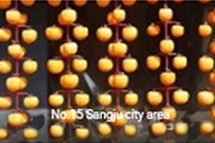
| Designation No. | No.15 | Name | Sangju Traditional Dried Persimmon | Location | Sangju city area |
|---|---|---|---|---|---|
| Main characteristics | Inheritance of traditional methods for dried persimmons, such as the management, processing, and selection of suitable sites for persimmon cultivation through the conservation of traditional varieties of ‘sangjudoongsi’ | ||||
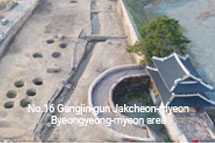
| Designation No. | No.16 | Name | Gangjin Embankment Ecological cycle Waterway Agricultural system | Location | 강진군 작천면 병영면 일원 |
|---|---|---|---|---|---|
| Main characteristics | Conservation of the unique Hamel-type water cycle irrigation system, including 16 embankments and 200 ponds, ‘Byeongyoungseong’ and waterways, and creating the special landscape of the Handeul Plain and embankments | ||||
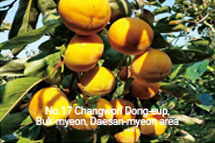
| Designation No. | No.17 | Name | Changwon Dokmoe Persimmon Agriculture | Location | Changwon Dong-eup, Buk-myeon, Daesan-myeon area |
|---|---|---|---|---|---|
| Main characteristics | The representative cultivation area for sweet persimmons, Korea’s only world No.1 product among fruit trees, and preserving its unique environment and technology for persimmon cultivation such as dokmoe agriculture, pond use, and pit fertilization. | ||||





